NEA Today October 2022
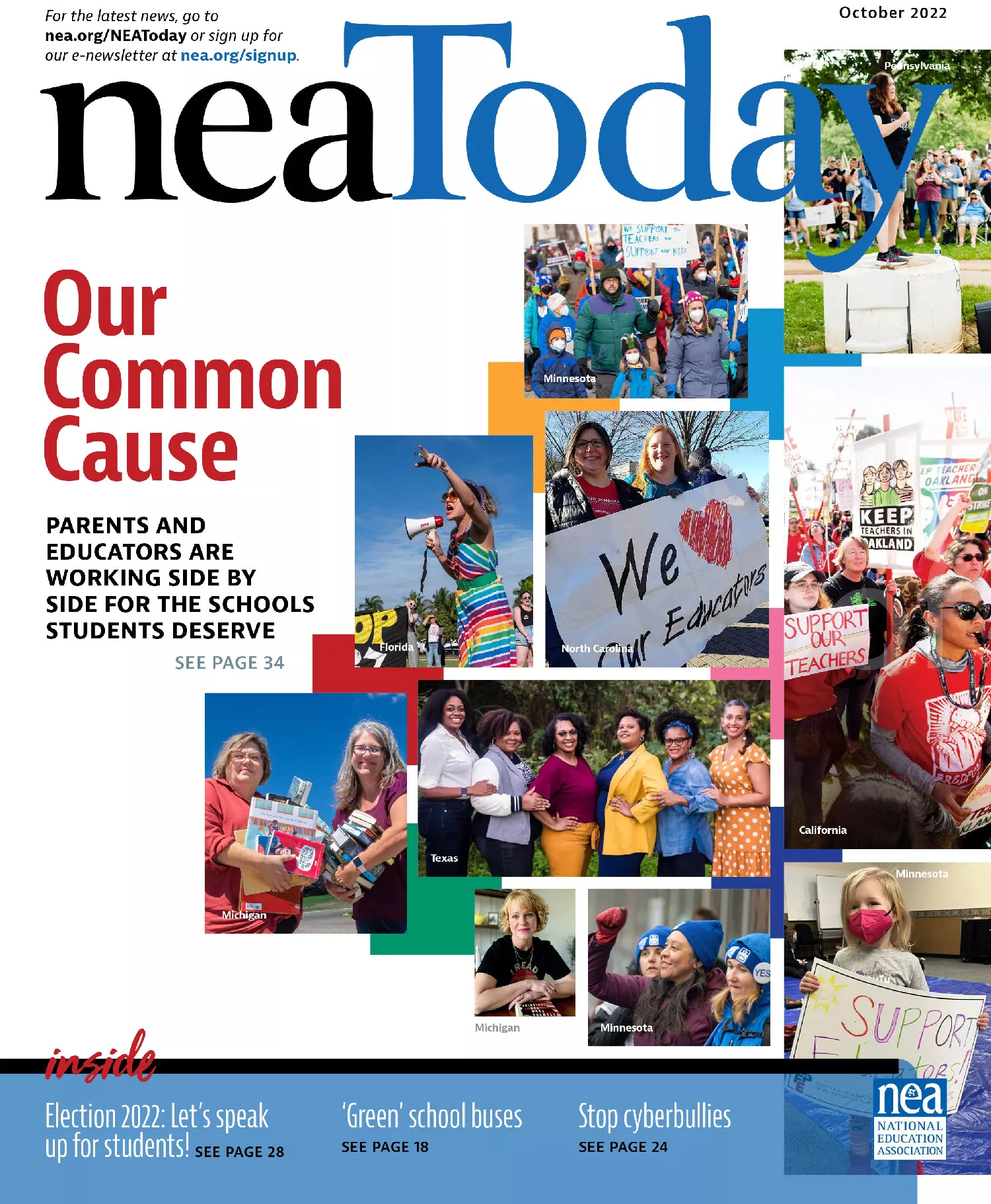
United We Stand
for Students
By working together, parents
and educators are proving to be
a formidable force in fighting for mental health supports, an honest
and accurate education, and full funding for public schools.
Election 2022: Speak Up for Students at the Polls
Well-funded schools, support for educator unions, and resources for our students—It's all possible if we elect pro-public education candidates.
When Body Language is Lost in Translation
Body language and social norms vary among cultures. Could you be misreading your students’ non-verbal cues?
Clear and Present Danger
What if the next school shooting
happens on
the bus?
Express Yourself!
Arts integration boosts engagement and equity in the classroom.
Pronouns and Why They Matter for LGBTQ+ Students
Have questions about gender pronouns? NEA has some answers.
Education Support Professionals
Electric School Buses
Are Gaining Ground
Vermont school bus driver James Johnson earned a seat behind the wheel of one of the first electric buses in his district. He’s part of a national trend toward “greener” buses.
Becky’s Journal of Joy, Justice, and Excellence
NEA's president visits schools in North Carolina, speaks out for authentic assessments, and recommends a favorite new audio collection.
In The Know
Racial Discrimination at School
Sources of stress can be fairly uniform for educators, except for one key factor: Teachers of color are more likely to experience racial discrimination at school.
A RAND survey, released in June, found that 36 percent of teachers of color (44 percent of Black teachers; 30 percent of Hispanic/Latino teachers; and 46 percent of Asian and Pacific Islander teachers) experienced at least one incident of racial discrimination in the 2021 – 2022 school year. Forty-three percent of teachers exposed to discrimination reported symptoms of depression, compared with 25 percent of their peers who had not experienced any incidents.
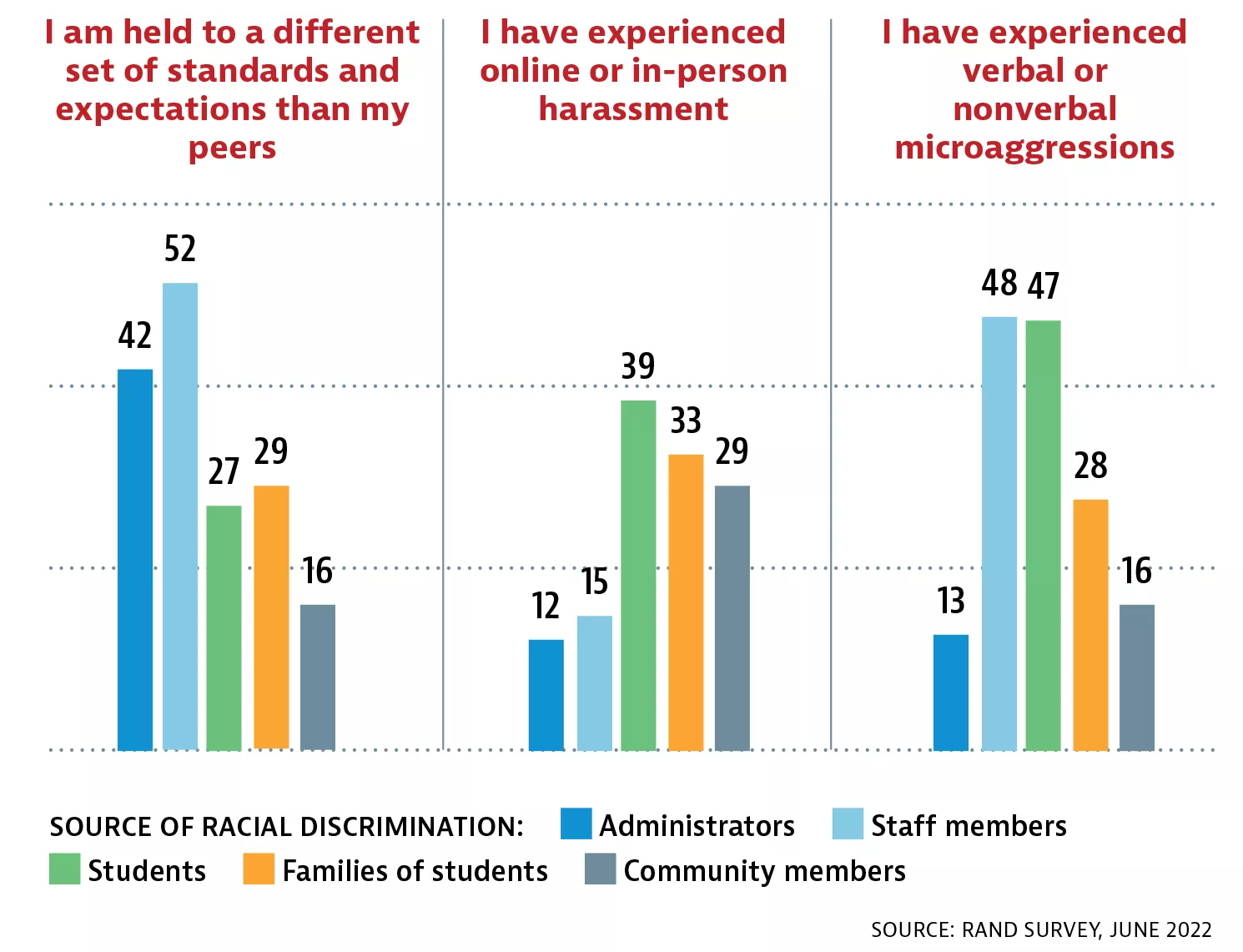
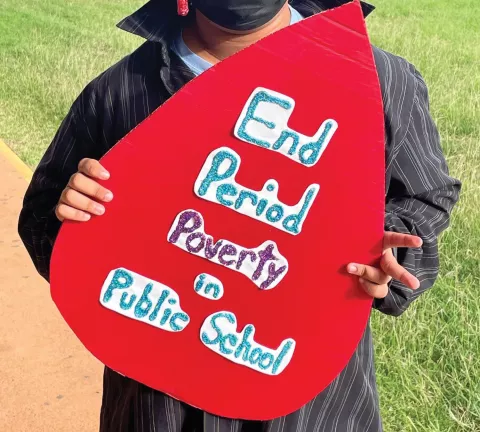
“With the power of education, we taught people what period poverty was, how it was a problem locally, and how it isn’t just a problem out there in the world, but an everyday one for students in classrooms.”
—Hawaii teacher Sarah “Mili” Milianta-Laffin, in June, when her state became the seventh in the nation to make period products free in public schools. Milianta-Laffin and her students worked closely with lawmakers to pass the legislation. Nearly a quarter of students in the U.S. struggle to afford period products.
The Benefits of Reading Paper Books

A study of teens in approximately 30 countries found that those who said they most often read paper books scored 49 points higher on the 2018 Program for International Student Assessment reading test than teens who said they rarely or never read books. The study, which tested 15-year-old students around the globe, found that those who read books more often on digital devices scored only 15 points higher than students who rarely read. In the United States, 31 percent of students said they never or rarely read books, compared with 35 percent worldwide. And 35 percent of U.S. students said they primarily read paper books.
—Organization for Economic Cooperation and Development
What is ‘Good Teaching’?

Who has an opinion about what makes “good teaching”? Practically everybody. But too often the debate disregards the complexity of classroom teaching. Researchers at the University of Maryland recently decided to identify practices and core factors that can produce positive student outcomes—along with challenges that crop up along the way.
The researchers used a unique data set from the National Center of Teacher Effectiveness (NCTE) that allowed them to gauge the work of 53 elementary school teachers in 4 school districts. They analyzed student math scores, videotapes of instruction, and survey responses from students who were asked to rate their classes.
The researchers found that there appeared to be a trade-off between teaching that results in higher test scores and teaching that engages students. For example, teachers who succeeded at raising test scores—usually focusing on “cognitively demanding” instruction—tended to be evaluated poorly by their students, and vice versa.
Of the 53 teachers studied, researchers found six who could do both types of teaching successfully, noting their emphasis on hands-on participation and establishing routines and procedures that promoted efficiency and order in the classroom.
Researcher David Blazar notes that NCTE collected the data in 2012 and tracked students into high school. Blazar’s preliminary findings suggest that engaging students has long-term benefits. Students who had more engaging elementary school teachers had higher math and reading achievement scores and fewer absences in high school.
Schools Are Still Segregated
As the U.S. student population grows more diverse every year, the nation’s schools remain sharply divided along racial, ethnic, and socioeconomic lines, according to a report by the U.S. General Accounting Office. In the 2020 – 2021 school year, more than a third of students (about 18.5 million) attended a school where 75 percent or more of the student population is of a single race or ethnicity. And 14 percent of students attended schools where 90 percent or more of the students were of a single race or ethnicity.

Percent of public K–12 students attending school where 75 percent or more of the students are of their own race or ethnicity
Students Prefer In-Person Learning
In April and May 2022, the Pew Research Center surveyed U.S. teenagers, ages 13 to 17, about their views on virtual learning and the overall impact the pandemic has had on their learning. Although the overwhelming majority of students preferred in-person learning, views differed by race, ethnicity, and household income.
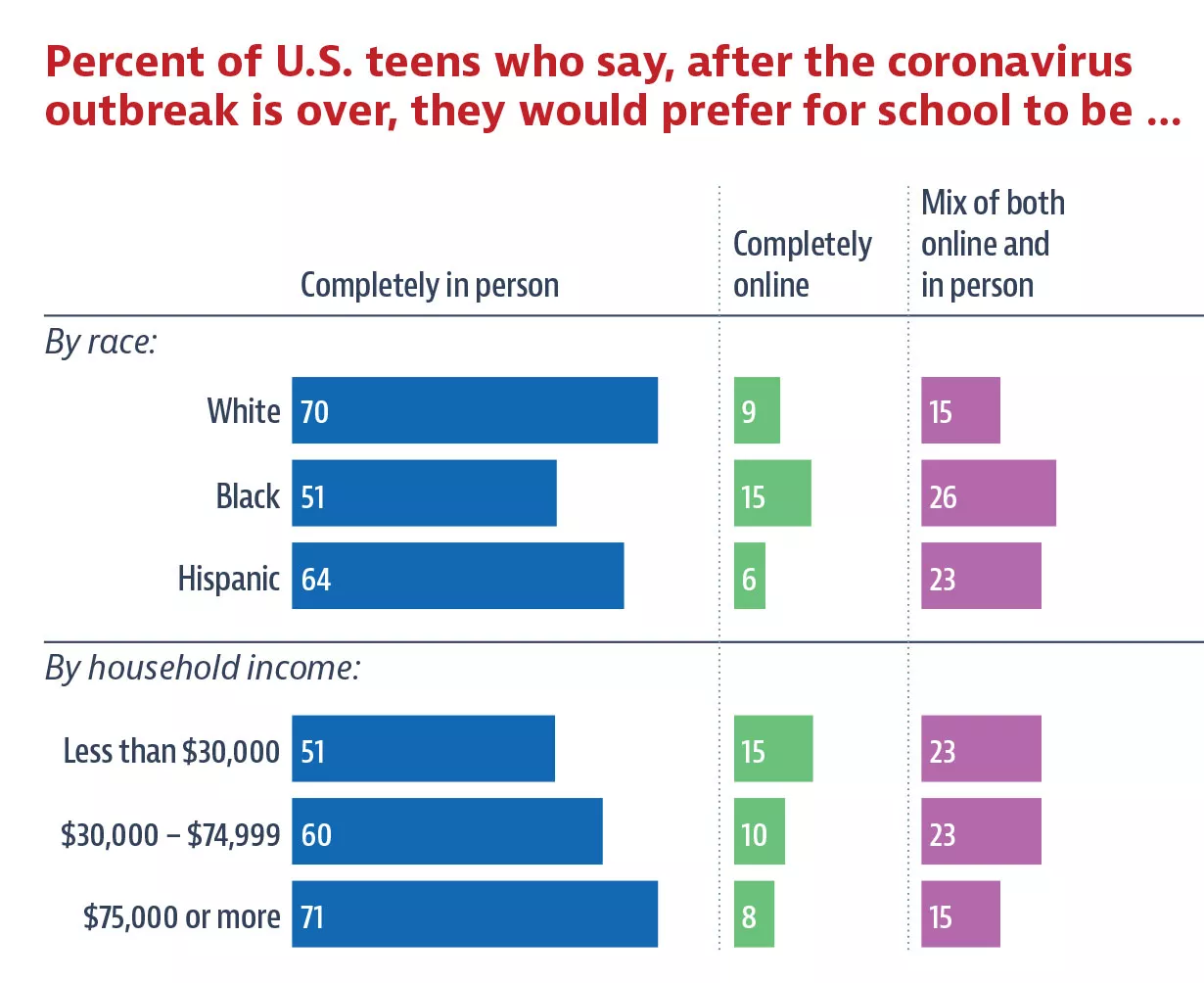
Note: White and Black teens include those who report being only one race and are not Hispanic. Hispanics are of any race. Those who did not give an answer are not shown.
Source: Pew Research Center, May 2022
Issues and Actions
How the Department of Labor can help fix teacher pay
By Edward Graham
NEA is working to change an outdated federal regulation that leaves 1.5 million teachers and adjuncts underpaid.
The blue glow from sixth-grade English teacher Brooke Davis’ laptop has become her 2-year-old son’s night-light. Every evening, as she coaxes Cooper to sleep with one hand, she’s also inputting her students’ grades and finishing up other administrative tasks she just couldn’t get to earlier in the day.
“I had hoped to accomplish some grading during my planning period,” she says. “Instead, I’ve spent that time covering other classes due to lack of substitutes, meeting with parents of kids with disabilities, drafting special education plans, returning parent phone calls, meeting with colleagues, and doing all the other duties that come with the job.
“Because there is no overtime for teachers, all this work goes unpaid,”
she says. “It’s another 12 hours of work for just eight hours of pay.”
Davis is not alone. More than
1.5 million teachers are affected by the “teacher exclusion” regulation, which drags down teacher pay.
The archaic federal regulation excludes some public school educators—including pre-K–12 and college adjuncts—from critical wage and hour protections. And the lack of competitive pay is forcing more educators out of the profession, compounding the national educator shortage.
NEA is leading the charge for a solution. To help stop the exodus of educators from our schools and campuses and ensure that teachers and adjuncts receive the pay that they deserve, NEA is calling on the U.S. Department of Labor to rescind this outdated policy that excludes them from receiving the same wage and hour protections as other professionals.
The ‘teacher exclusion’ regulation
First adopted in 1938, the Fair Labor Standards Act (FLSA) is the federal law that establishes national minimum wage and hour standards, including overtime pay or compensatory time for employees who work more than 40 hours a week. Under the law, employees are only “exempt” from these protections if, among other things, they are paid a salary and earn above a certain salary threshold.
While the law provides critical protections for many employees across the U.S., teachers and adjuncts have never received those salary safeguards. They were placed in the same category as doctors and lawyers, who work in professions that pay double or even triple the amount that educators make.
By preventing teachers and adjuncts from qualifying for FLSA’s protections, regardless of their salary levels or whether they receive hourly wages, the teacher exclusion regulation drives down starting salaries for educators. This in turn drives down the recruitment and retention of teachers, exacerbating the nation’s educator shortage crisis.
6 Ways the Fair Labor Standards Act Exclusion Hurts Educators and Students
The ‘teacher exclusion’ drives down salaries.
- About 1.5 million teachers and higher education adjuncts are directly affected by the regulation. They are hourly or salaried employees who earn less than the FLSA’s current salary threshold of $684 per week.
- The FLSA exclusion drives down teachers’ starting salaries. When adjusted for inflation, teacher salaries have declined 4 percent over the past decade.
The FLSA regulation groups teachers with much higher paying professions.
- The average median salary for K–12 teachers during the 2019 – 2020 school year was $63,645; the median salary for doctors was $208,000 in 2020, and $126,930 for lawyers.
- FLSA regulations treat educators the same as those making double or even triple their salaries.
Teacher pay affects students, too.
- Increasing teacher salaries has a positive impact on students’ academic success. One study found that increasing teacher pay by 10 percent lowers student dropout rates by 3 to 4 percent.
- Low pay is one factor driving educators away from the profession, compounding the educator shortage. When we have fewer educators, students pay the price.
Learn More
Read NEA’s full report, “Ending the FLSA Teacher Exclusion.”
Our Voices
Close-Up
Food network champ teaches his trade in Vermont school

Culinary arts teacher Adam Monette won top prize ($25,000!) on the Food Network’s Holiday Baking Championship, in December. His winning dessert? A holiday party-themed cake. The St. Albans, Vt. educator credits some of that win to working with students at Northwest Career and Technical Center.
For more than 10 years, Monette has trained students in banqueting and events, cooking à la minute (made to order), plating and presentation, and more. His students learn the theory, philosophy, and history of cooking. They learn how to break down whole animals as well as different methods for cooking meat.
“I tell the kids: ‘If you want to be an expert at something, you teach somebody how to do it,’ and I’m reteaching these [cooking] skills every single year,” says Monette.
The other ingredient that helped Monette secure the win: Time.
Each culinary arts class is two hours long, and the lesson or meal of the day must be started and completed within that period. “I’m used to working in time frames, and so during the show there were moments when I was done 30 to 45 minutes before the other competitors,” recalls Monette.
But the even bigger win is the opportunities Monette opens up for his students in career and technical education (CTE)—also known as vocational or trade school.
Multiple pathways to success
Monette says he teaches students science disciplines, such as chemistry, physics, and anatomy, as well as the “precision of a neurosurgeon and the critical thinking skills of an engineer.”
His students graduate with an industry-recognized credential called ServSafe Manager; earn three college credits; and have a leg up in food service and hospi-tality industry.
They could pursue a career in horticulture, beverages, health services, or food photography. They could work on a cruise ship, at a resort, or in a Michelin-starred restaurant.
“There are jobs everywhere within this field,” Monette says.
The demand for CTE educators is high: An average of more than 17,000 positions are projected each year over the next decade, according to the U.S. Bureau of Labor Statistics. The good news is that the Biden administration is pumping billions of dollars into strengthening and expanding the U.S. workforce, which includes investing in CTE programs.
“The benefit to career tech for students is that it’s tangible, authentic learning,” Monette says. “We have real outcomes and allow kids to find their vocation in life.”
—BRENDA ÁLVAREZ
What are you grateful for?
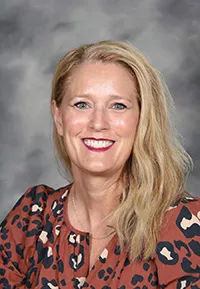
“All the teacher mentors I’ve had in my 30-year career. They made me the teacher I am today.”
—Kristen Michalski, Wisconsin
“I am grateful for a governor who keeps advocating for our public schools, despite a legislature that opposes him at every turn. Thumbs up to Tony Evers!”
—Dianne F., Wisconsin

“I’m grateful for beautiful notes from former students!”
—Sandra Chong Fuller, Illinois
“For students eager to learn … . And aren’t they all until someone tells them they are not?”
—Sharon W., New York
“Parents, community members, politicians and admin that support teachers in word and action.”
—Danielle P., Tennessee
“Now that I am retired, I am grateful that students and parents still want to keep in touch, as well as occasionally look to me for guidance and advice. Once a teacher, always a teacher!”
—Sharon C., Washington
“Our great pension system!”
—John C., New York
Share This
We want to know what’s on your mind. We asked this question on NEA Today’s Facebook page and received so many great answers! Keep an eye on facebook.com/neatoday for our next question, and share this link with your fellow NEA members.
Member Spotlight
We Rise Together

Anastasia Jimenez, Senior Office Assistant, Phoenix, Arizona
“When I first got involved with the union, representing ESPs like myself and other educators, I was a bit timid. But then I began to see how often ESPs weren’t at the table—even though we are so important to how schools operate and whether kids thrive. As I moved into various leadership roles, I fought alongside other ESPs to better the profession. We fought to get fair wages, improve often exhausting workloads and schedules, and secure relevant professional development. … It’s up to us to uplift one another.”
Learn More
For more member stories or submit the name of an educator you’d like to see featured.
Try This
Technology
Help Students Deal with Cyberbullies
Teachers play a central role in preventing cyberbullying. Among students who report being victims of cyberbullying, 23 percent will turn to a teacher first for help. So educators need to know how to respond and facilitate communication between the parent and the school.
Engage
7 Tips for Engaging With Families
By Hannah Gross

When parents and caregivers are involved in their child’s education, they can help students succeed in school, graduate, and stay on a path to college or a career.
Akilah Alleyne, director for K-12 Education at the Center for American Progress, says successful family and parent engagement plans start with community conversations.
To help spark these conversations, try these strategies from the National PTA and ParentsTogether:
1. Host a focus group or listening session to find out how families feel about their interactions with the school.
Utah’s Provo City School District hosted a virtual focus group for parents of students who receive special education services. The district invited the families’ feedback on the strengths and areas for improvement within their school’s program.
2. After an event, ask families how the PTA and school can support their children.
Use a mini-poll at each PTA meeting or in the school newsletter that asks about a wide range of issues affecting students and the school. The PTA can then use the parents’ feedback when making decisions.
3. Talk with families directly, when possible, instead of sending out mass emails.
Families can easily delete generic email invitations or throw away a flyer that comes home in their child’s backpack. A personalized invitation can make parents feel welcomed and valued. Noel Grisham Middle School PTA, in Austin, Texas, encouraged a big turnout at a schoolwide dessert night by having students invite their own families.
4. Use name tents or name tags at community events.
Brookview Elementary PTA, in Cleveland, Ohio, hosted Back to School Bingo with cards including every staff member’s name. The event allowed everyone to get to know the school family and learn the names of the people they would be working with throughout the school year.
5. Avoid using acronyms or making inside jokes.
Welcome all parents and build trusting relationships from the start with communications that are crystal clear. Keep it simple and direct and invite family perspectives. When reports or other communications include unfamiliar acronyms and jargon, many families won’t understand what’s being said and will leave the event disengaged and unlikely to return.
6. Hold PTA sessions led by experts.
APPLES PTA, in Stamford, Conn., hosted a story time that doubled as a training session to help parents and caregivers encourage their children to become successful readers. The read-aloud showed families how to read in engaging ways and emphasized that 3- and 4-year-olds can develop key reading skills even before they know how to read.
7. Create a Facebook group or email chain to stay in touch.
Ailen Arreaza’s son Lucas finished his first year at a North Carolina elementary school, where he made many new friends. As the year came to a close, Lucas wondered how he would invite his friends to his fifth birthday party over the summer. Ailen and another parent decided to create a Facebook group for all of the parents in the class. This allowed them to stay in touch, share resources about summer camp, and connect about their plans for the following school year.
Share This
Pass these tips along to a colleague or parent.
Share your magazine, or share online using the NEA Today app, available in the App Store or Google Play.
Editor's Note
NEA Today Has a New Look!
You’ll probably notice that this issue of NEA Today looks considerably different. Your magazine has the same great content you love, but NEA Today now has a fresh design and even more opportunities for you to engage with your association. This new design reflects the energy and passion that you—the members of NEA—bring to your work each day.
Your magazine will continue to be a doorway into the NEA community, inviting you in to explore NEA resources and helping you become more active in our collective mission—to make public schools equitable, inclusive spaces where all students can learn and thrive.
When we embarked on this redesign, we first listened to all of you. We held focus groups and surveyed thousands of members—including teachers, education support professionals, aspiring educators, and retirees alike.
You told us you wanted to know how to make a difference, and we heard you. You’ll see “Take Action” and “Learn More” flags with links to actions and resources that can help support you and your students. And “Share This” prompts offer opportunities to share what you’ve read and learned with a colleague.
We know you are pressed for time, so you’ll be able to breeze through some stories while others are perfect for a deep read on a weekend afternoon.
We are excited to continue bringing you stories of your fellow educators, from towns large and small. Plus, all of you—NEA’s amazing members—now take center stage in the “Our Voices” section. Be sure to check out “Quick Takes” to hear what members are saying across the country. You’ll also find hands-on classroom tips and professional development resources in every issue: Expand “Try This” above.
We hope you love the new look of NEA Today, because it’s made by you. NEA members, we hear you, we see you, and your magazine reflects you, too.
Between issues, you can always read the latest NEA Today news at nea.org/NEAToday, sign up for our e-newsletter at nea.org/signup, or download the NEA Today app.
NEA in Action
Boosting Union Power and Salaries
NEA continues to sound the alarm on low educator pay and its direct link to educator shortages nationwide.
Starting teacher salaries nationwide will increase by 1.6% in 2020 – 2021.
The good news: Collective bargaining, long championed by NEA, helps educators get higher wages across the board.
NEA helps win raises for members in non-bargaining states, too. With NEA’s support, the Mississippi Association of Educators scored a historic pay raise for teachers this year.
Taking Action on Gun Violence
Millions of dollars will now go to school safety programs and mental health services for children and families—in large part thanks to NEA members’ relentless advocacy. The funds are part of the most significant federal gun safety law in decades, which Congress passed in June.
Getting More Funding to Schools
NEA members are making sure federal funds from the American Rescue Plan go where they will have the most impact for their students, such as:
- Hiring more intervention specialists and school counselors
- Training and retaining bus drivers
- Reducing class sizes
Learn how to apply school rescue funds in your district at nea.org/funding-the-recovery.
Triple victories in South Carolina!
The South Carolina Education Association secured major victories during their 2022 legislative session. Here’s what they won at the Statehouse:
- Duty-free break
- Thirty minutes without assigned duties for K–5 teachers.
- Pay raises
- A minimum starting teacher salary of $40,000.
- Funding for school supplies An increase in the teacher school supply fund to $300 per teacher per year.
“We will be unwavering in our demands; undaunted by the challenges; unapologetic about our advocacy; and we will stand with our backs straight and unyielding. We will fight for what we know is right! —NEA President Becky Pringle said, in June, on a radicalized Supreme Court issuing decisions that do not reflect the views or the values of most Americans.
A better future for all students
NEA adopted a new policy during its 2022 Representative Assembly, in July, furthering its commitment to safe, just, and equitable schools where all students and educators can thrive. The policy focuses the following principles and actions:
- Adopt a restorative justice philosophy to create a school climate that rejects the criminalization and policing of students.
- Provide training and support for culturally competent instruction.
- Develop and implement plans to end disparities in disciplinary and behavioral practices.
- Create community-centered schools that foster safe, positive environments and engage all members of the public school.
Five Ways…
to Make Your Classroom More Welcoming and Inclusive
Make your classroom a place where students know they are accepted for who they are and where they are in life
By Janet Rivera Mednik
1. Present a balanced view of accomplishment.
It’s a fact that most celebrated figures of history are male, White, and straight. But you have the power to change the script and showcase the achievements of women, People of Color, and other identities. You can also avoid fueling stereotypes. Florence Nightingale and Michael Jordan made impressive contributions, but there are countless others whose achievements go beyond the stereotypes of women caring for men and African American men being athletic. Consider drawing attention to someone who defied the expectations of the day—such as Katherine Johnson, an African American mathematician who helped NASA accomplish historic crewed spaceflights.
2. Ace the name game.
Saying names correctly reinforces acceptance and respect. It’s a tall order to memorize so many names as quickly as possible, but the rewards of building classroom community and increasing student engagement are worth it. Conversely, mangling a name or “deadnaming”—using a name that they no longer associate with—can lead to feelings of alienation. Some effective strategies include using name tents, writing names phonetically, and encouraging students to refer to each other by name, instead of, “I agree with what he said.” (See Page 46 to learn about the importance of using students’ chosen pronouns.)
3. Make your classroom
a soft place to land.
After the stress of the last few years, students may feel as though they are behind academically or feeling awkward among their peers, especially without the anonymity of a face covering. Let students know that it’s okay to mess up sometimes. If your school has the resources, have pencils and other classroom supplies readily available to avoid drawing attention to forgetfulness or a bad financial situation. When a reluctant child finally speaks up, respond positively. When a student bombs a quiz or a project, take the time to write a short personal note of encouragement.
4. Think of your classroom
as a community.
Practices that encourage community-building pay dividends in making a classroom hum. Hold regular class meetings to help set an inclusive tone and ask for students’ input in establishing classroom norms. Then refer back to these norms when there are disruptions. This early “buy-in” helps students see that they are critical to the decision-making process and creates a classroom community of learners.
5. Develop relationships.
Educators know how important it is to determine a student’s academic baseline, but the benefit of getting to know the student behind the letter grades cannot be underestimated. A “getting to know you” questionnaire at the beginning of a term is always helpful, but be sure to make connections with each student throughout the year. Relationships are a two-way street, which is why educators who share personal stories and insights with their students gain an extra benefit: trust. Let students know why you chose teaching, recount stories of failure and how you overcame setbacks, and share your passions.
For More
Want to create a welcoming classroom for all students? NEA offers micro- credentials on equity and cultural competence.

